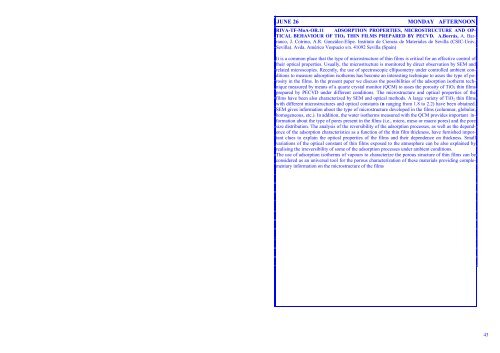Wüest M. 51 Wykes M. 82 Yamaguchi M. 17 Ybarra G. 129 Yubero F ...
Wüest M. 51 Wykes M. 82 Yamaguchi M. 17 Ybarra G. 129 Yubero F ...
Wüest M. 51 Wykes M. 82 Yamaguchi M. 17 Ybarra G. 129 Yubero F ...
You also want an ePaper? Increase the reach of your titles
YUMPU automatically turns print PDFs into web optimized ePapers that Google loves.
JUNE 26 MONDAY AFTERNOON<br />
RIVA-TF-MoA-OR.11 ADSORPTION PROPERTIES, MICROSTRUCTURE AND OP-<br />
TICAL BEHAVIOUR OF TIO 2 THIN FILMS PREPARED BY PECVD. A.Borrás, A. Barranco,<br />
J. Cotrino, A.R. González-Elipe. Instituto de Ciencia de Materiales de Sevilla (CSIC-Univ.<br />
Sevilla). Avda. Américo Vespucio s/n. 41092 Sevilla (Spain)<br />
It is a common place that the type of microstructure of thin films is critical for an effective control of<br />
their optical properties. Usually, the microstructure is monitored by direct observation by SEM and<br />
related microscopies. Recently, the use of spectroscopic ellipsometry under controlled ambient conditions<br />
to measure adsorption isotherms has become an interesting technique to asses the type of porosity<br />
in the films. In the present paper we discuss the possibilities of the adsorption isotherm technique<br />
measured by means of a quartz crystal monitor (QCM) to asses the porosity of TiO 2 thin films<br />
prepared by PECVD under different conditions. The microstructure and optical properties of the<br />
films have been also characterized by SEM and optical methods. A large variety of TiO 2 thin films<br />
with different microstructures and optical constants (n ranging from 1.8 to 2.2) have been obtained.<br />
SEM gives information about the type of microstructure developed in the films (columnar, globular,<br />
homogeneous, etc.). In addition, the water isotherms measured with the QCM provides important information<br />
about the type of pores present in the films (i.e., micro, meso or macro pores) and the pore<br />
size distribution. The analysis of the reversibility of the adsorption processes, as well as the dependence<br />
of the adsorption characteristics as a function of the thin film thickness, have furnished important<br />
clues to explain the optical properties of the films and their dependence on thickness. Small<br />
variations of the optical constant of thin films exposed to the atmosphere can be also explained by<br />
realising the irreversibility of some of the adsorption processes under ambient conditions.<br />
The use of adsorption isotherms of vapours to characterize the porous structure of thin films can be<br />
considered as an universal tool for the porous characterization of these materials providing complementary<br />
information on the microstructure of the films<br />
43
















